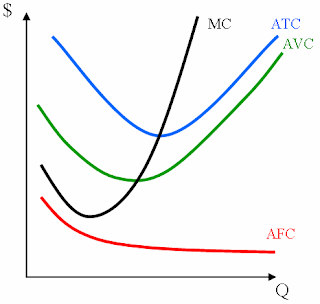
Banerjee and Duflo, in their paper, "The Economic Lives of the Poor" for which I wrote a small summary adress the problem of a lack of scale of microenterprises. This problem essentially means that many microenterprises operate at such a small scale, that they actually are not efficient. In microeconomic terms, efficiency is reached if average unit costs are minimized. If we have decreasing marginal cost (or constant marginal costs and fixed costs, which are spread of a larger number of units), this will imply decreasing average costs.In industrial economics, there exists then something which is called the "minimum efficient scale", which corresponds to scale where average unit costs are minimized. The minimum efficient scale will tell us, how many firms will operate in a long run equilibrium in a certain, perfectly competitive market at zero profits.
Now -- what does all this microeconomics have to do with microenterprises or microentrepreneurship? Banerjee and Duflo give the example of "dosa" makers in Indian cities.
Dosas are filled pancake like pastries, which constitute a typical breakfast in India. They write, that on any given morning, in urban slums women open some stalls on the streets and sell "dosas" to passerby's. Making and selling dosas essentially neither requires skills nor any capital equipment. So there is a situation where we literally have free entry.
Most of the time spend by women is to wait for passing by customers. Banerjee and Dulfo argue:
"Many of these businesses are probably operating at too small a
scale for efficiency. The women making dosas spend a lot of time waiting:
having fewer dosa-makers who do less waiting would be more efficient. In fact,
it might make sense in efficiency terms for the dosa-makers to wor in
pairs: one to make the dosas and one to wrap them and make change."
But why don't the women team up?
There must be a mechanism that prevents this from happening. Potentially, one mechanism is a behavioral one - lack of trust?
Or it may simply be, that as soon as somebody teams up with somebody else, another dosa maker opens their stall at the now vacated one, thus reducing the rate of arrival of new customers for all other dosa makers. So there may be something like a common pool problem, where all dosa makers essentially earn the average revenue. A common pool problem is for example the cause of overfishing, as essentially all fishers earn the same average revenue, each marginal fisher will actually reduce the average revenue of all other already existing fishers.
Here, each additional dosa maker reduces the rate of arrival of customers for all other dosa makers. So, when individuals do not team up, they essentially all earn the same average revenue. Now, if two individuals team up in an attempt to increase scale, actually, the average revenue for all others goes up, making it attractive for somebody else to open a stall for the now vacated one.
Now, however, the ones that teamed up need to split this revenue by two, which would render them worse off as before. So what they observe may something be like a self-enforcing bad equilibrium, that due to free entry maintains itself and makes it impossible for the dosa makers to actually reach the efficient region.
Maybe such a logic (I am of course not sure whether the argument is fully consistent, but it somewhat seems plausible), is the cause for a lack of growth of microenterprises in developing countries.


Keine Kommentare:
Kommentar veröffentlichen